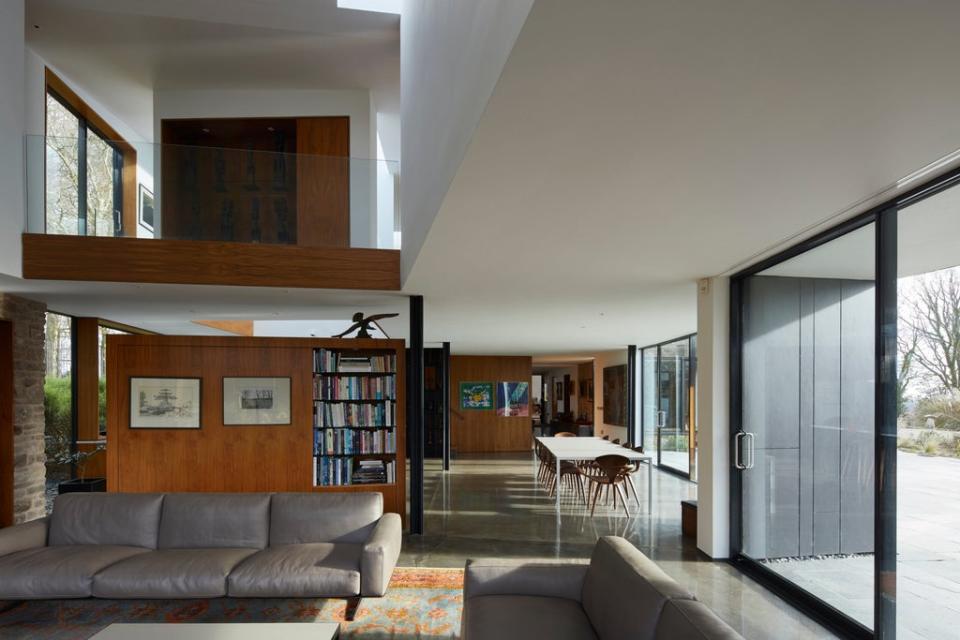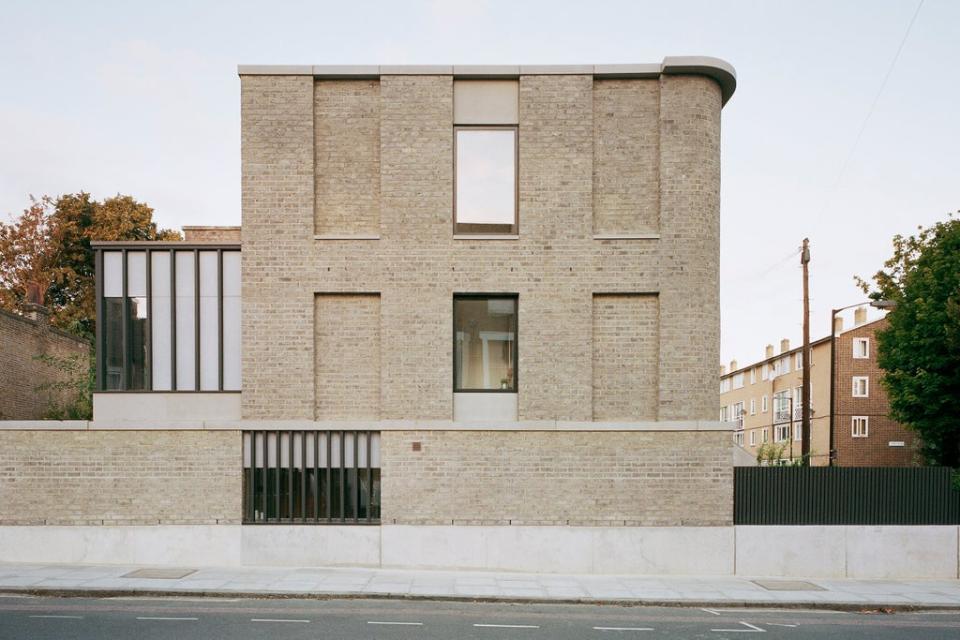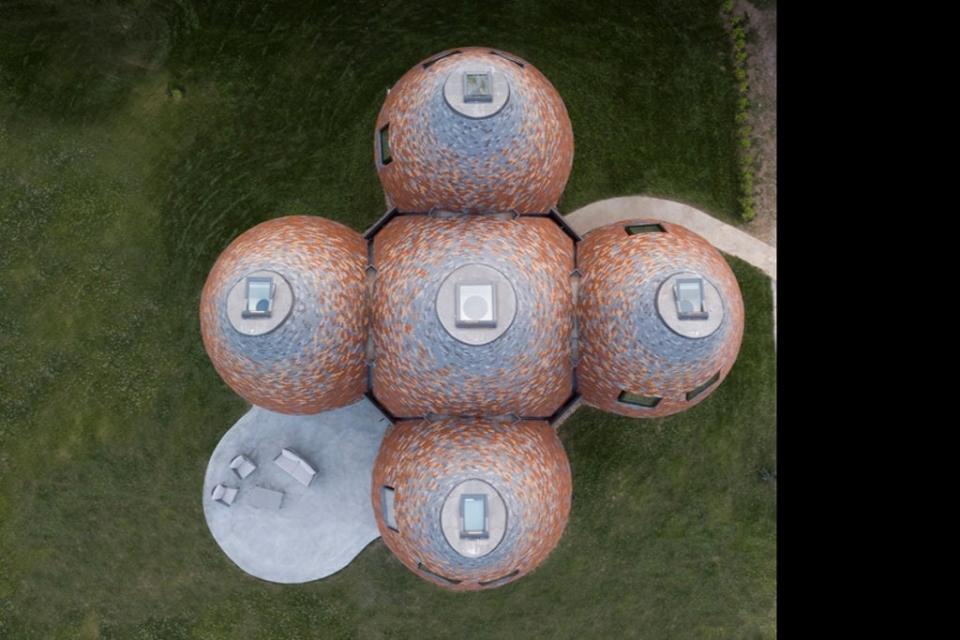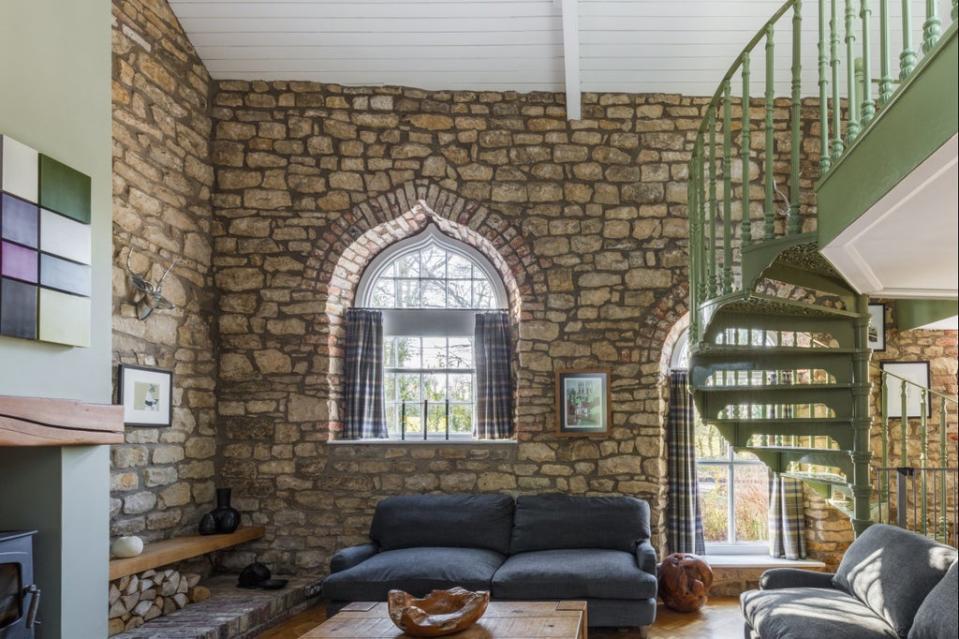House of the Year 2021 revealed: Gloucestershire hilltop farmhouse and art gallery named Britain’s best home

A transformed 18th century farmhouse-cum-art gallery, at the highest point of Gloucestershire, has been named the RIBA House of the Year Award 2021.
The winner was revealed in the final episode of Grand Designs: House of the Year tonight on Channel 4 at 9pm, the last of a four-part series visiting the most cutting edge architectural residential projects from the last 12 months.
Architect Alison Brooks led the redesign of the stone house into a home and a gallery of Indian and African sculpture.
Named House on the Hill, it stands prominently in front of its modern side extension which is a black, sleek monolithic structure. Its darkness is a nod to the nearby Forest of Dean.
On one side of the farmhouse, three floors have been hollowed out into one gallery space with soaring ceilings, there are also two bedrooms and a study on this side of the property.
The space flows into the modern extension with no separation where there is an open plan kitchen, dining and living space, two more bed rooms and an office with a balcony.
McCloud described it as a collection of angles and skewed geometries which take you into new encounters and spaces throughout the building. Every room has three view points (albeit windows or roof lanterns) which show the sky or the surrounding greenery.
The grand finale is the outdoor pool in a dry-stone walled garden.

RIBA president Simon Allford says: "This geometric design skilfully fuses together the old with the new - connecting two architectures separated by over 300 years.
"Intriguing and distinguished its the impressive result of a ten-year collaboration between the homeowners and architect. It’s an extraordinary labour of love."
The House on the Hill was selected from five other entrants in the category: homes that surprise in the first programme of the series.
As well as the overall winner, the episode tonight also featured the five entrants in the final category: homes that reinvent, and the sub winner of that theme which was a masterclass in how to modernise a typical Victorian terrace house in London.
The house on the corner
Architect: 31/44
At the end of a seemingly ordinary Victorian terrace in London is a striking new corner house that compliments the existing architecture, while setting a new standard.
Covered in rugged brick with a sleek raised and glazed extension, this home nods to the rest of the street. It has a curved corner walls to mimic the pub over the road and an arched doorway.

Developer Sarah has taken traditional ideas and played with them such as a the canopy which looks like the entrance next door.
The triple aspect site allows glazing on both sides leading into courtyards so light flows through the downstairs, which can be dark and narrow in Victorian terraced homes. Plywood storage cleverly hides the downstairs toilet and the micro thin cement floor maximises the ceiling heights.
“It showcases the elegance of the past in a very contemporary way,” says Ogundehin.
The house on the corner was up against four other entrants – all reinventions of old buildings. Here’s the round-up.
The Kentish house of cones
Architect: Acme
The first entrant on the show tonight is a Kent classic: a converted oast house once used for drying hops to brew beer.
The five red brick roundalls push circular living to the limit, says McCloud.
Clad in 41,000 hand-trimmed tiles, the walls are curved, there are circular stairs, even the mirrors, sinks and lights are spherical.

Wooden tiles clad the internal walls all the way up to the point of the cone.
Downstairs a kitchen, sitting room, guest bedroom and study all open off a singular round hallway.
McCloud describes it as “magical and primal” with the charm of an “igloo or yurt.”
An eco home on a country estate
Architect: McLean Quinlan
Two retired software engineers Nigel and Eileen have built a Passivhaus behind an old walled garden which was once part of a country estate in Devon.
It’s deceptively large with a secret basement for a media room and a huge central atrium. An open plan living and dining room, library and four bedrooms run off the hall.
Burrows says its modest and understated with a strong connection to nature through the glazed internal courtyards and their new kitchen garden on the site of the old one. It’s earthy with clay-rendered walls and reclaimed tiles under foot.

Looking up there’s a 20m triple glazed skylight to ensure it meets Passivhaus energy efficiency standards.
“It’s a 21st century blueprint of a country house, quietly luxurious, super energy efficient and in harmony with its setting,” he says.
Suburbia but not as we know it!
Architect: Wilkinson King Architects
As McCloud arrives at the property, down a leafy spur urban street in Surrey’s Weybridge, he calls it “a fresh, delightful slice of something cool and elegant.”
The modern family home, built by photographer Sarah, to live in with her husband and three children, is a dappled grey brick box.
There are no obvious stud walls inside but a huge light-filled open plan space of glass, engineers timber and plywood.

“We didn’t want a white box,” Sarah explains. The Lemonade Veneer Lumber which makes up the exposed beams and structure gives off a warm pink hue and glass walls between areas allow light to bounce all the way through the house.
“There are crystal clear views through the building all way front of the house that faces the street,” says McCloud.
Much-loved former village school
Architect: ArkleBoyce
Certain buildings make a village, such as the pub or post office, or primary school. This Grade II listed Victorian village schools has been reimagined at the back, behind the restored and retained facade.
The former educational institution contains a double height living room and mezzanine bedroom, behind it is a playroom and open plan kitchen diner, with a bathroom and two further bedrooms above.

Behind is a low slung extension clad in dry stone walling with a master bedroom pod on top. It’s the home of James and architect Gail and their two boys.
The RIBA judges praised the wrap-around glazing and clever use of steel.
“It deliberately stands apart allowing the building to shine in its 170-year-old glory but with a new exciting chapter to the old school’s story,” says Burrows.
Read More
House of the Year 2021: the five homes in the running for top RIBA prize on Grand Designs tonight
Riba House of the Year 2021: inside the four London homes in the running for top architecture prize

 Yahoo Finance
Yahoo Finance 